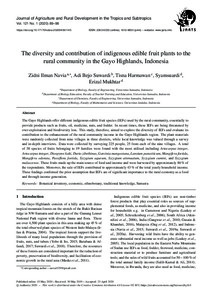Aufsatz

The diversity and contribution of indigenous edible fruit plants to the rural community in the Gayo Highlands, Indonesia
Abstract
The Gayo Highlands offer different indigenous edible fruit species (IEFs) used by the rural community, essentially to provide products such as fruits, oil, medicine, nuts, and fodder. In recent times, these IEFs are being threatened by over-exploitation and biodiversity loss. This study, therefore, aimed to explore the diversity of IEFs and evaluate its contribution to the enhancement of the rural community income in the Gayo Highlands region. The plant materials were randomly collected from nine villages in three districts, while local knowledge was valued through a survey and in-depth interviews. Data were collected by surveying 225 people, 25 from each of the nine study areas,. A total of 38 species of fruits belonging to 19 families were found with the most utilised including Artocarpus integer, Baccaurea motleyana, Diospyros kaki, Durio zibethinus, Garcinia mangostana, Lansium parasiticum, Mangifera foetida, Mangifera odorata, Passiflora foetida, Syzygium aqueum, Syzygium attenuatum, Syzygium cumini, and Syzygium malaccense. These fruits made up the main source of food and income and were harvested by approximately 86 % of the respondents. Moreover, the sale of IEFs contributed to approximately 43 % of the total yearly household income. These findings confirmed the prior assumption that IEFs are of significant importance to the rural economy as a food and through income generation.
Citation
In: Journal of Agriculture and Rural Development in the Tropics and Subtropics (JARTS) Vol. 121 / No. 1 (2020-05-15) , S. 89-98 ; EISSN 2363-6033Additional Information
Gedruckte Ausgabe im Verlag kassel university press erschienen.Collections
Vol 121, No 1 (2020) (Journal of Agriculture and Rural Development in the Tropics and Subtropics (JARTS))Citation
@article{doi:10.17170/kobra-202004061145,
author={Navia, Zidni Ilman and Suwardi, Adi Bejo and Harmawan, Tisna and Syamsuardi and Mukhtar, Erizal},
title={The diversity and contribution of indigenous edible fruit plants to the rural community in the Gayo Highlands, Indonesia},
journal={Journal of Agriculture and Rural Development in the Tropics and Subtropics (JARTS)},
year={2020}
}
0500 Oax
0501 Text $btxt$2rdacontent
0502 Computermedien $bc$2rdacarrier
1100 2020$n2020
1500 1/eng
2050 ##0##http://hdl.handle.net/123456789/11561
3000 Navia, Zidni Ilman
3010 Suwardi, Adi Bejo
3010 Harmawan, Tisna
3010 Syamsuardi
3010 Mukhtar, Erizal
4000 The diversity and contribution of indigenous edible fruit plants to the rural community in the Gayo Highlands, Indonesia / Navia, Zidni Ilman
4030
4060 Online-Ressource
4085 ##0##=u http://nbn-resolving.de/http://hdl.handle.net/123456789/11561=x R
4204 \$dAufsatz
4170
5550 {{Essbare Frucht}}
5550 {{Vielfalt}}
5550 {{Lebensunterhalt}}
5550 {{Ländlicher Raum}}
5550 {{Sumatra}}
7136 ##0##http://hdl.handle.net/123456789/11561
<resource xsi:schemaLocation="http://datacite.org/schema/kernel-2.2 http://schema.datacite.org/meta/kernel-2.2/metadata.xsd"> 2020-05-19T12:23:54Z 2020-05-19T12:23:54Z 2020-05-15 doi:10.17170/kobra-202004061145 http://hdl.handle.net/123456789/11561 Gedruckte Ausgabe im Verlag kassel university press erschienen. eng Namensnennung 4.0 International http://creativecommons.org/licenses/by/4.0/ botanical inventory economic ethnobotany traditional knowledge Sumatra 630 The diversity and contribution of indigenous edible fruit plants to the rural community in the Gayo Highlands, Indonesia Aufsatz The Gayo Highlands offer different indigenous edible fruit species (IEFs) used by the rural community, essentially to provide products such as fruits, oil, medicine, nuts, and fodder. In recent times, these IEFs are being threatened by over-exploitation and biodiversity loss. This study, therefore, aimed to explore the diversity of IEFs and evaluate its contribution to the enhancement of the rural community income in the Gayo Highlands region. The plant materials were randomly collected from nine villages in three districts, while local knowledge was valued through a survey and in-depth interviews. Data were collected by surveying 225 people, 25 from each of the nine study areas,. A total of 38 species of fruits belonging to 19 families were found with the most utilised including Artocarpus integer, Baccaurea motleyana, Diospyros kaki, Durio zibethinus, Garcinia mangostana, Lansium parasiticum, Mangifera foetida, Mangifera odorata, Passiflora foetida, Syzygium aqueum, Syzygium attenuatum, Syzygium cumini, and Syzygium malaccense. These fruits made up the main source of food and income and were harvested by approximately 86 % of the respondents. Moreover, the sale of IEFs contributed to approximately 43 % of the total yearly household income. These findings confirmed the prior assumption that IEFs are of significant importance to the rural economy as a food and through income generation. open access Navia, Zidni Ilman Suwardi, Adi Bejo Harmawan, Tisna Syamsuardi Mukhtar, Erizal Essbare Frucht Vielfalt Lebensunterhalt Ländlicher Raum Sumatra publishedVersion EISSN 2363-6033 No. 1 Journal of Agriculture and Rural Development in the Tropics and Subtropics (JARTS) 89-98 Vol. 121 false </resource>
The following license files are associated with this item:


